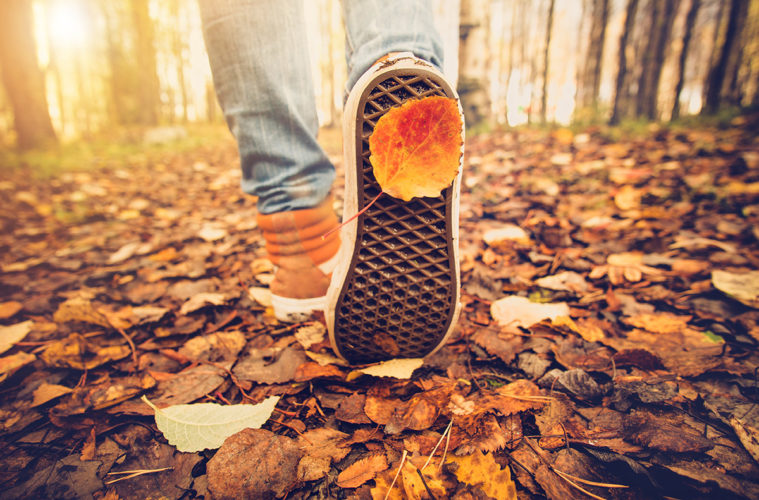BY LINDSAY CUTLER
Fun for a minute and then just a giant chore. They’re yellow, red, and orange; they flitter and flutter as they fall, sparkling against the clear blue skies of fall; we crunch, kick and jump; we enthusiastically rake up the first few, dutifully bag them and set them on the curb for trash pickup. After all, they are just trash, right?
Actually, leaves are so much more than trash. They are a natural part of a forest ecosystem that simultaneously smothers weeds and nurtures the soil. Leaves are the Spanx of the garden – keeping in what you don’t want and highlighting the best of what you’ve got. The best part about learning the truth about leaves is that it really lightens your investment of time, money, and fossil fuels, while keeping mountains of waste out of the landfill. It can be difficult to watch your neighbors putting in so much work while you carve pumpkins and take leisurely leaf peeping hikes with your people so following are leaf uses ranked from least energy required to most.
Least energy input:
Leave them be. Sweep or rake leaves onto your garden bed. Left unraked, you have the perfect recipe to smother unwanted weeds. Leaves of any size can be placed around flowers and shrubs to slowly decompose, hold in moisture, and keep weeds down. The smaller the leaf size, the faster it will break down into enriched soil. Layers of leaves will grow leaf mold, a white stringy substance that is gardener’s gold in England. Gardeners like this stuff so much that we will collect leaves in bags or bins to cultivate it for use over the course of the year. This works here, too. Bonus, no need to purchase new mulch in Spring – now you’ve saved time, energy, and money twice while drastically reducing your consumption of plastic bags.
Low energy input:
Here in Colorado we have low moisture and so very slow rates of decomposition. That means we have to put in a little more work than gardeners in New York or England do. If left unraked on your lawn, leaves would soon smother the grass, inhibiting its growth, and leading to patchy spots in the spring. Mowed up into your grass, leaves become a mulch, enriching the soil, retaining moisture throughout the dry spells of winter, and contributing to a rich green lawn come spring. Extra mowed leaves can be put in a compost pile to add brown matter over the course of the winter, bagged to grow leaf mold, spread on top of the leaves you left in your garden beds to provide a more attractive and uniform mulched look.
Medium energy input:
Bagged leaves are the best for adding to muddy areas such as pathways, side yards, and chicken coops. If you must spend the time raking and bagging because it gets you out of the house or reminds you of your childhood, then try to find the space to store them on site for use throughout the muddy months of winter and spring. In the chicken coop they provide entertainment and nutrition for the birds as they scratch and peck their way through the piles for any insects and seeds hidden away in there and they rapidly break down into black gold – rich compost perfect for raised bed gardening. In the coop, they keep the smell down and the birds clean which is exactly what they can do for your muddy spots, too. Spread them wherever you are sick of the squelch.
High energy input:
If you have no mud or space to store bags, drop those leaves off for recycling. Denver turns them into mulch which you can get back for free when you’re ready. You workaholics still get to rake and bag, and you also get to drop them off at the local leaf collection sites. It also allows you to get out of the house come spring to drive to the mulch giveaway site, load up bags or bins or a borrowed pickup, truck it back home, and spread it into the garden. This is a great option for those who don’t have the space to store leaves and who simply have too many fall to the ground to use them all.
Highest energy input:
Shred them all with a leaf shredder and then spread them back into the garden. This requires raking, bagging, feeding into a loud and heavy gasoline powered shredder, rebagging, and respreading throughout the yard. The shredders constantly clog, can’t handle cottonwood leaves or large twigs or mulch chunks, and you inevitably get tired long before the leaves are taken care of and resort to your original MO of setting them out for trash pickup. Don’t do this option.
Overall recommendations:
Leave a thin layer of unshredded leaves in all garden beds to smother spring weeds. Mow the rest. Mowing leaves is the absolute easiest way to shred them and this can be done by raking or blowing a giant mountain of leaves onto your lawn and running the mower for a half hour or so. That’s one less tool for the shed and has the advantage of mowing and mulching your lawn at the same time. It also reduces the quantity of leaves down to about a fifth of the original volume so you can bag and store some for mud, mold, or black gold. You can sit back with a warm mug of hot cider, and watch your neighbors work.

